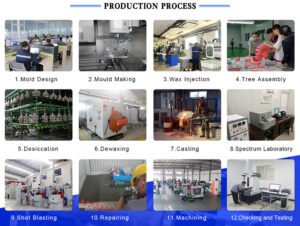
The Investment Casting Process: From Design to Finished Product
Investment casting is a precision casting process that creates near net shape parts, resulting in high quality, accurate end products. The process begins with the design of the casting and ends with the finished product, involving several key steps along the way.
Design and Modeling
The first step in the investment casting process is the design and modeling of the part. The design process involves creating a three-dimensional model of the casting using CAD (computer-aided design) software. The model must accurately represent the desired shape and dimensions of the finished product, taking into account the necessary tolerances and engineering considerations.
Pattern Making
Once the design is completed, a pattern is made from a material such as wood, plastic, or metal. The pattern is designed to create a mold that will replicate the desired shape of the casting. The pattern is prepared using the CAD data and then undergoes a series of modifications and adjustments to ensure its accuracy.
Mold Preparation
The next step is to prepare the mold, which is created using a refractory material such as silica sand. The sand is packed around the pattern and then the pattern is removed, leaving a cavity in the sand that will form the shape of the casting. The mold is then thoroughly dried and prepared for pouring.
Casting
Casting involves pouring molten metal into the mold cavity and allowing it to solidify. The molten metal is poured into the mold at a controlled rate to ensure an even distribution of the metal and to prevent any air bubbles from forming. Once the metal has solidified, the mold is broken open and the casting is removed.
Finishing and Inspection
The casting undergoes a finishing process that may include machining, grinding, and polishing to achieve the final dimensions and surface finish required. The casting is then inspected to ensure its accuracy and compliance with engineering specifications. A non-destructive testing method such as X-ray or ultrasound may also be used to check for any hidden imperfections or voids in the casting.
Assembly and Delivery
Once the casting has been finished and inspected, it is ready for assembly into the final product. The casting is sent to the assembly area where it is integrated with other components to create the finished product. The final product is then packaged and delivered to the customer.
In conclusion, investment casting is a highly effective process for creating high-quality, accurate metal parts. The process involves design and modeling, pattern making, mold preparation, casting, finishing and inspection, and assembly and delivery. Each step in the process must be carefully planned, executed, and controlled to ensure a high-quality end product. With the use of modern CAD/CAM software tools and advanced materials, investment casting remains a reliable and cost-effective manufacturing method for a wide range of industries.
